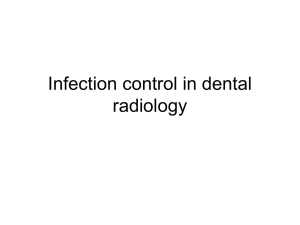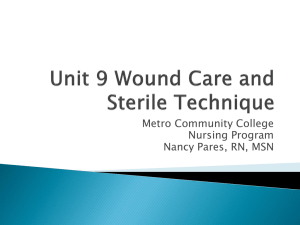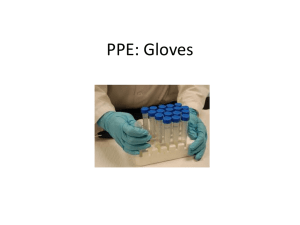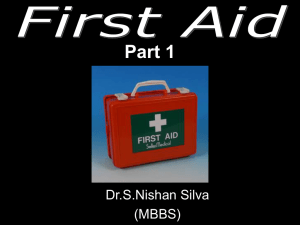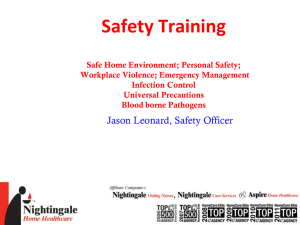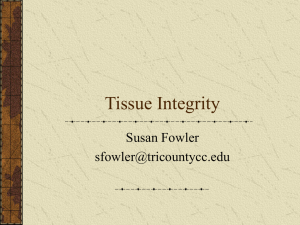WOUND CARE RULES - Tamaqua Area School District
advertisement
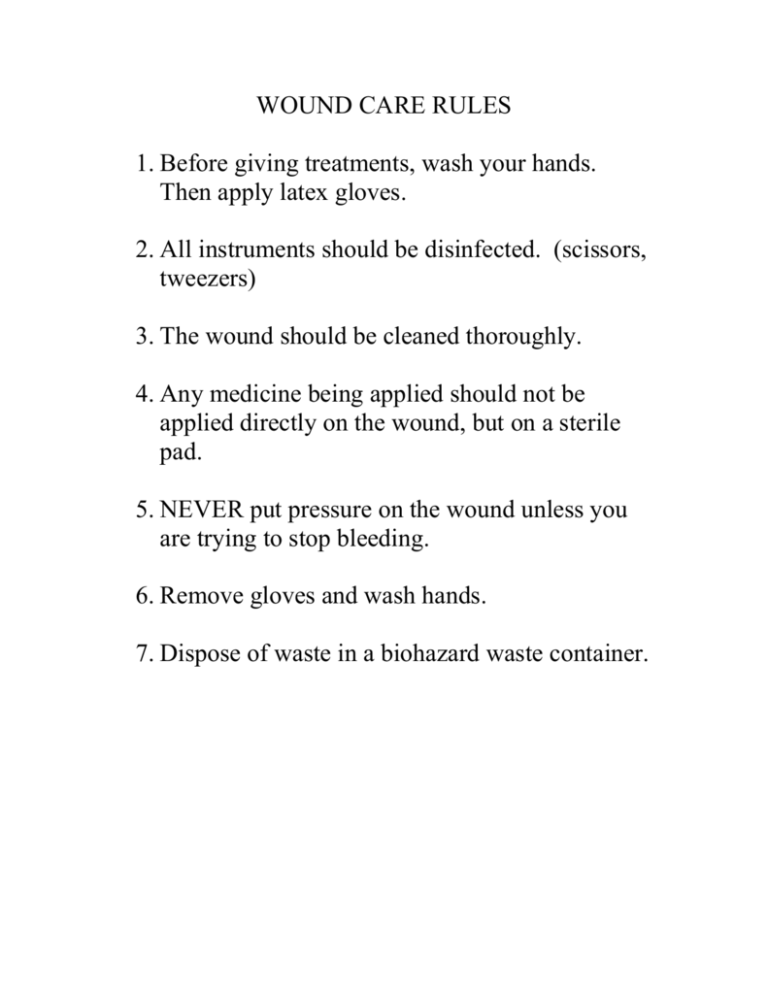
WOUND CARE RULES 1. Before giving treatments, wash your hands. Then apply latex gloves. 2. All instruments should be disinfected. (scissors, tweezers) 3. The wound should be cleaned thoroughly. 4. Any medicine being applied should not be applied directly on the wound, but on a sterile pad. 5. NEVER put pressure on the wound unless you are trying to stop bleeding. 6. Remove gloves and wash hands. 7. Dispose of waste in a biohazard waste container. Signs of infection The date of your last tetanus shot should be kept on record because cleansing and medication may not be enough to prevent infection!!!! Keep a close watch on players 2-7 days after an injury for infection. Signs may be: 1. Pain, swelling, redness, heat, and loss of function. 2. May have a mild fever or headache 3. Llymph glands may become swollen and painful. (neck, armpit, and groin). To prevent the spread of infection: 1. Clean and disinfect hands. 2. Clean other equipment like whirlpools, scissors, and training tables. CHAPTER 4 BIOHAZARDOUS PROTOCOLS I. O.S.H.A. GUIDELINES (Occupational Safety and Health Administration) A. Regulations concerning exposure to bloodborne pathogens in the workplace were published in 1992. B. Many schools and companies do not understand the regulations and are not in compliance. C. Not understanding the rules does not protect them from enforcement penalties if investigated by OSHA. D. Risk of actual infection with a bloodborne disease is still small, but growing; especially from Hepatitis B. 1. Hep. B is a viral infection that affects the liver and can be fatal. 2. There are an estimated 2.5 million people infected with HIV, the majority of whom do not have visible symptoms of the disease. a. No cure or vaccine for HIV II. Frequently asked questions regarding OSHA standards: A. What is the OSHA bloodborne pathogens standard? 1. It requires procedures for protecting employees of any type of company, organization, or institution against accidental exposure to bloodborne pathogens. 2. Became effective March 6, 1992. B. Is my school covered by this standard? 1. Yes 2. If your school has employees who, when doing their job, can reasonably be expected to come in contact with human blood, certain body fluids, or infectious waste, the school must comply. C. In a school setting, who might be at risk of exposure? 1. athletic trainers 2. coaches 3. school nurse 4. teachers providing first aid 5. custodians (clean up) 6. laundry workers handling blood-soaked uniforms 7. game officials/referees D. What are the basic provisions of OSHA # 1910.1030? 1. Scope (who is covered?) 2. Exposure control plan a. A written plan defining the steps you take to cut down your chances of exposure to BBP. 3. Methods of compliance a. written rules on how to control exposure 4. Vaccinations and medical evaluations a. Hepatitis B shots b. Post exposure medical evaluation and follow-up care. 5. Info. and training a. How will my employees learn the requirements? 6. Record keeping a. What records must be kept? 7. Dates a. When are standards in effect? E. Can NCAA or other national governing body issue rules that supersede the OSHA standard? 1. No guidelines supersede the OSHA standard. F. If my school is in compliance with regulations of its national governing body, is it in compliance with the OSHA standard? 1. No. No other regs can be substituted for them. G. Can blood be removed (by an employee) from a player’s uniform and be in compliance with the regulation? 1. The standard odes not specifically prohibit the removal of blood from a uniform. It does say the only approved method of removing blood from a uniform is to put it through a complete wash cycle with a commercial laundry detergent. OSHA discourages removing blood from uniforms with a chemical spot remover. H. What about spraying a disinfectant on the blood spot? 1. Is not approved as an effective means to disinfect a potentially contaminated uniform. III. Bloodborne Pathogens A. Trainer’s primary concern it the health of athletes. B. They must also be concerned with their own personal safety. C. It is foolish for the ATC to assume no athletes are contaminated with a deadly disease. D. Preventative measures must be known and practiced. IV. Preventive and Protective Measures in Waste management A. Ways a trainer could be exposed to BBP: 1. Caring for an athlete with some sort of bloody wound. 2. Serum fluid in blisters. 3. Vomitus with an ill athlete. 4. Saliva in spittle. B. Precautions to be taken: 1. Wear latex gloves when working on athletes with exposed body fluids. 2. Wear gloves when evaluating an athlete because of the possibility of an undiscovered open wound. C. Guidelines for wearing latex gloves: 1. Change after 10-15 min. because protective value goes down after that long. 2. If gloves tear, replace the immediately. 3. Choose correct size to fit your hand. 4. Change gloves when you give care to different persons. 5. Do not clean or reuse gloves. 6. How to remove used gloves: 1. Turn inside out, beginning at the wrist and peeling them off. 2. To remove 2nd glove, DO NOT touch the soiled surfaces with your bare hand. Hook the inside of the glove at the wrist and peel the glove off. 7. After use, gloves and all contaminated materials should be disposed of properly in a biohazard infectious waste container. D. Guidelines for cleaning a contaminated area or training room: 1. Prepare bleach/water solution: a. Add 1 ounce bleach to 10 ounces of water. b. Put in spray bottle. c. Water must be cool to avoid de-activation of bleach’s basic cleaning agent, “hypochlorite”. d. Label bottles and store in a safe place. e. Solution is good for only 1 day; must be made daily. 2. Put on latex gloves. 3. Absorb fluid with paper towels. 4. Saturate area with bleach solution and allow soaking before absorbing it with another paper towel. 5. Scrub area with bleach solution and then soap and water, using a paper towel. 6. Rinse the area. 7. All soiled materials, including gloves, should be placed in the biohazard bag/container. 8. Wash hands thoroughly after disposal of materials. V. National Federation of State High School Associations A. NFSHSA, in 1994, adopted 9 Communicable Disease Procedures. B. It outlines the protocols that should be followed in the handling of bodily fluids. C. They are: 1. Stop bleeding and remove blood from uniforms. 2. Use precautions when handling body fluids. 3. Wash body surfaces exposed to body fluids. 4. Clean all surfaces and equipment before resuming play. 5. Properly dispose of sharps and body fluids. 6. Use artificial ventilation devices when performing CPR. 7. Support personnel must follow precautions if their skin is broken. 8. Follow accepted guidelines for controlling bleeding. D. These guidelines are not identical to the OSHA guidelines and are not universal precautions. E. NFSHSA has also established specific rules on bleeding players specific to each sport. VI. Classification and Management of Wounds A. Wounds involve a compromise to the integumentary (skin) system. B. Once the skin is penetrated, various types of wounds could exist: 1. abrasions 2. avulsions 3. incisions 4. lacerations 5. punctures C. Treatment for a wound should be immediate. D. A wound care kit should include: 1. disposable gloves 2. sterile gauze 3. sterile dressing/bandage 4. sterile water 5. biohazard bag E. Always wear gloves when treating a wound. F. Follow OSHA guidelines. G. Watch for signs of infection. VII. Wound Management A. Abrasions 1. Outer layer of skin scraped away on a hard surface. 2. Limited bleeding due to the rupture of small veins and capillaries. 3. Prone to infection due to dirt ground into torn tissue. 4. Initial care: a. latex gloves b. follow OSHA guidelines c. clean with soap and water to scrub particles out of wound d. apply anti-bacterial ointment e. place dressing on affected area and cover with bandage 5. Follow-up care a. change dressing daily b. watch for signs of infection c. keep wound moist with topical ointment so it will heal from the inside out. B. Avulsions 1. A forceful separation or tearing of tissue from the body in which bleeding occurs immediately. 2. Initial care: a. Use latex gloves and follow OSHA guidelines. b. Apply direct pressure with sterile gauze. c. Elevate affected anatomical structure. d. Watch for severe bleeding. e. Transport athlete to a physician [medical referral is required]. f. Wrap avulsed body part in a sterile gauze pad. g. Place wrapped body part in container of sterile water. 3. Follow-up care: a. Follow Dr.’s directions in changing the dressings. b. Watch for signs of infection. C. Incision 1. A wound with smooth sides/edges caused by a sharp object, such as glass or metal. 2. With potential damage to anatomical structures, severe bleeding can exist. 3. Initial care: a. Put on latex gloves, and follow OSHA guidelines. b. Using sterile gauze, cleanse area with soap and water to scrub particles out of wound. c. Apply sterile gauze and direst pressure. d. Elevate affected anatomical structure e. Watch for severe bleeding. f. Transport the athlete to a physician. Medical referral is recommended. 4. Follow-up care: a. Follow Dr.’s directions in changing the dressings. b. Watch for signs of infection. D. Laceration 1. A jagged, irregular tear in the soft tissue. 2. Initial care: a. Put on latex gloves, and follow OSHA guidelines. b. Using sterile gauze, cleanse area with soap and water to scrub particles out of wound. c. Apply sterile gauze and direct pressure for severe bleeding. d. Transport the athlete to a physician. Medical referral is recommended. 3. Follow-up Care: a. Follow Dr.’s directions in changing the dressings. b. Watch for sign of infection. E. Puncture 1. Small hole in the tissue produced by an object (nail) piercing the skin layers. 2. Limited external bleeding 3. Internal damage to organs may cause bleeding. 4. Initial care: a. Put on latex gloves and follow OSHA guidelines. b. Using sterile gauze, cleanse area with soap and water to scrub particles out of wound. c. Medical referral is recommended. 5. Follow-up care: a. Follow Dr’s directions in changing the dressings. b. Watch for signs of infection.
